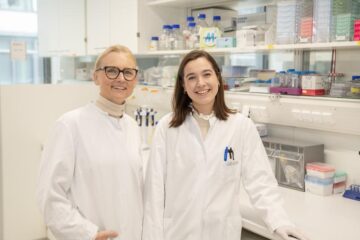Translational research work has patented the first experimental treatment against idiopathic pulmonary fibrosis

Because of lack of an effective treatment, they rarely survive 5 years after being diagnosed. Idiopathic pulmonary fibrosis affects 13 out of 100,000 men and 7 out of 100,000 women, normally over 40 years of age. Researchers from the Biomedical Research Institute of Barcelona CSIC (IIBB-CSIC), a centre developing research in the framework of the Institut d’Investigacions Biomèdiques August Pi i Sunyer (IDIBAPS), have discovered and patented a method to stop and revert this disease in an animal model. A clinical study will be soon conducted in humans in the Hospital Clínic de Barcelona.
Results of their research work are published in the last issue of the American Journal of Respiratory and Critical Care Medicine (176(12):1261-8). This study has had the collaboration of basic researchers, such as Dr. Anna Serrano-Mollar, and Dr. Oriol Bulbena, first and last signatories of the study; and researchers with a clinical background, such as Dr. Antoni Xaubet, from the Unit of Pneumology of the Hospital Clínic de Barcelona. This turns this work into a paradigm of translational research promoted in IDIBAPS and through other initiatives such as the Network of Centres of Biomedical Research (CIBERs). This research work has been financed through a contribution from the Fondo de Investigaciones Sanitarias (FIS) from the Instituto de Salud Carlos III.
Gas exchange is developed in lungs thanks to type 1 pneumocytes in alveoli, cells recovering the inner walls of the alveolar cavity. Occupying the same spaces, there are also type II pneumocytes, precursor cells that repair the damaged alveolar tissue. When idiopathic pulmonary fibrosis appears, this regeneration process cannot be developed correctly and fibrosis advances until respiration is impossible. The technique developed by researchers from the IIBB-CSIC-IDIBAPS consists in a transplantation of type II pneumocytes via intratracheal. In order to monitor correctly the transplanted cells with genetic and fluorescence techniques, sexual chromosomal differences were used. Thus, the disease was induced in female rats, and cells from male rats were transplanted. This is a lowly invasive technique which has permitted to regenerate, for the first time, rat fibrotic alveoli where idiopathic pulmonary fibrosis was induced.
CSIC has patented as a treatment the cell suspension transplanted with this innovative strategy. The world patent will be proved in humans with a clinical study, soon conducted in the Hospital Clínic de Barcelona thanks to the financing of the Fundación Genoma España and CSIC This study will have the participation of 6 recently diagnosed patients who will receive a suspension of type II pneumocytes coming from a dead donor, since these cells cannot be cultured in the laboratory. All this events throw new and hopeful light into basic and clinical research lines. One of the following steps of researchers will be to try to obtain type II pneumocytes from adult stem cells.
Media Contact
More Information:
http://www.clinic.ub.esAll latest news from the category: Health and Medicine
This subject area encompasses research and studies in the field of human medicine.
Among the wide-ranging list of topics covered here are anesthesiology, anatomy, surgery, human genetics, hygiene and environmental medicine, internal medicine, neurology, pharmacology, physiology, urology and dental medicine.
Newest articles

Possible alternative to antibiotics produced by bacteria
Antibacterial substance from staphylococci discovered with new mechanism of action against natural competitors. Many bacteria produce substances to gain an advantage over competitors in their highly competitive natural environment. Researchers…

Researchers have found brown fat’s “off-switch
Researchers from the University of Southern Denmark, the Novo Nordisk Center for Adipocyte Signaling (SDU), the University of Bonn and the University Hospital Bonn (UKB) have found a protein that…

Combining robotics and ChatGPT
TUM professor uses ChatGPT for choreographies with flying robots. Prof. Angela Schoellig has proved that large language models can be used safely in robotics. ChatGPT develops choreographies for up to…





















